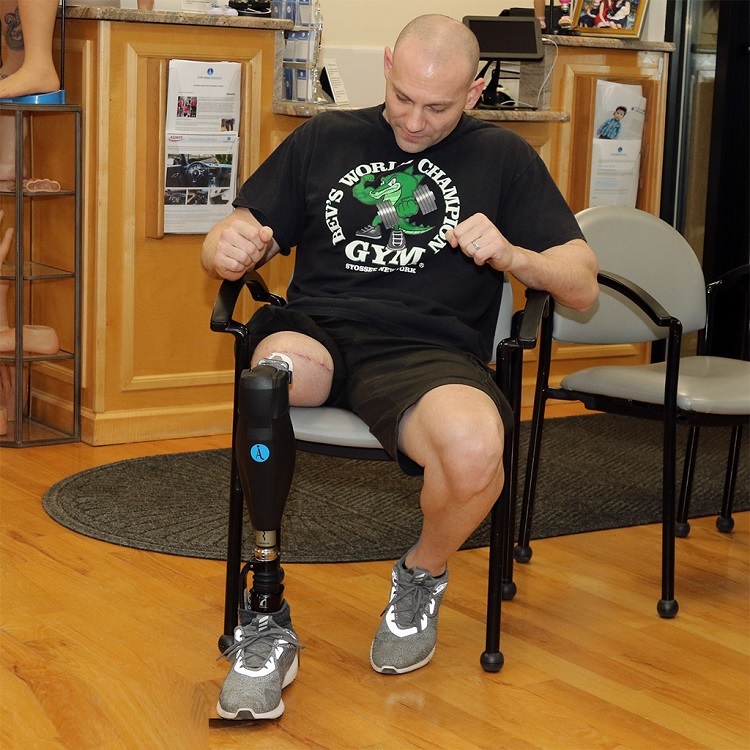It’s only been 18 months since the FDA approved osseointegration (OI) surgery for US amputees with above-knee amputation. That’s far too short an interval in which to generate significant data about patient outcomes, particularly when the bone-anchoring technique that’s approved for general use here—the OPRA system—requires two separate surgeries and about 12 months from first incision to the end of the rehab cycle. Most OI amputees in this country are total newbies who’ve only lived with their new devices for a few months, so it’s way too soon to draw any conclusions about their experiences.
However, OI surgery has been generally available for more than half a decade in Europe and Australia, long enough for researchers to start drawing some meaningful conclusions about the benefits of bone-anchored prostheses. And a pair of papers published this spring provide some hard evidence to support OI’s basic promise: that it improves mobility, stability, and proprioception, while eliminating the challenges that come with sockets.
We hasten to add that this research is far from definitive—the patient populations under study number in the dozens, still a relatively narrow sample. And there’s no certainty that outcomes achieved under European and Australian health care systems are completely replicable in the US system, which generally has higher costs and less generous access to care. Still, these studies are more comprehensive than any we’ve seen heretofore, assessing larger numbers of OI recipients across a longer time span.
Bearing these caveats in mind, here are a couple of evidence-based top-line findings.
Patient Satisfaction With OI Is Through the Roof
The most eye-popping statistic we’ve seen appears in a paper published last month in the European Journal of Trauma and Emergency Surgery. In that study, 76 percent of above-knee amputees with OI said they were “absolutely satisfied” with their prosthesis, compared to just 11 percent of socket-wearing amputees. The researchers (from Hannover Medical School in Hannover, Germany) surveyed 139 individuals on a broad range of metrics, addressing everything from mobility to employment status, outpatient care, anxiety/depression, general health markers, and overall quality of life. Participants ranged from two to four years post-OI surgery, putting them well beyond the recovery and rehab horizon.
The paper contained a second, more clinically valid measure of patient well-being via the Satisfaction with Prosthesis (SAT-PRO) metric, a standard survey that’s been around since the late 1990s. Respondents with OI devices averaged a score of almost 90 (on a scale of 0 to 100), about 30 points higher than the score for socket-wearing amputees. A similar spread turned up in responses to another survey the researchers used, the Questionnaire for Persons With a Transfemoral Amputation (Q-TFA). OI patients averaged a quality-of-life score of nearly 80 (on a scale of 0 to 100), about 30 points higher than the average for socket-wearing amputees.
“[T]ransfemoral amputees treated with an osseointegrated prosthetic attachment (TOPS) showed statistically significant higher scores for mobility and satisfaction,” the paper concludes. “This demonstrates the high potential of TOPS in the prosthetic treatment of patients with transfemoral amputation with regard to getting on [with] daily life and positive impact on their quality of life.”
The Rewards of OI Do Not Come Without Risk
One of the world’s most prolific OI surgeons is Munjed al Muderis of Sydney, Australia. He developed press-fit osseointegration, an alternative bone-anchoring system to OPRA with a shorter recovery/rehab horizon. At the annual conference of the British Limb Reconstruction Society earlier this year, al Muderis presented outcomes analysis of 93 press-fit OI patients worldwide. With an average followup time of 6.5 years post-surgery, these patients are among the longest-tenured OI amputees and therefore provide a unique snapshot of medium-term outcomes.
Before we continue, we should note that press-fit OI is not generally available in the United States (although it’s possible to have the procedure via special-use exemptions). That’s a significant distinction to keep in mind—it’s not clear how relevant outcomes with press-fit implants may be for patients with OPRA patients.
The good news: all 93 people in al Muderis’ study cohort continue to use their OI prosthesis, with measurable improvements in mobility, functional proficiency, and self-reported quality of life. But the cohort suffered eight periprosthetic fractures, a serious complication that usually requires a surgical fix. Overall, these 93 patients required a total of 19 revision surgeries to correct fractures and other complications, along with 43 surgical debridements to treat infections and other skin- and wound-care issues.
“At five years post-surgery, osseointegration continues to provide amputees with improvements on function and quality of life which were previously unattainable with socket prosthesis,” the paper concludes. “However, the benefits are accompanied with a relatively high risk of adverse events.”
Bonus study: OI improves sit-to-stand function
A paper due to appear in next month’s edition of Clinical Biomechanics documents improved biomechanical performance in four American OI amputees. The researchers measured their subjects’ kinematics during sit-to-stand tasks both pre- and post-OI surgery and found significant improvements in trunk, pelvic, and hip movement, “likely reduc[ing] the risk of the development and/or progression of overuse injuries, such as low back pain and osteoarthritis.”
